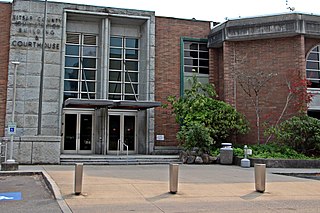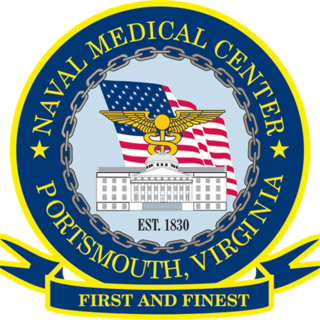
Puget Sound Naval Shipyard, officially Puget Sound Naval Shipyard and Intermediate Maintenance Facility, is a United States Navy shipyard covering 179 acres (0.7 km2) on Puget Sound at Bremerton, Washington in uninterrupted use since its establishment in 1891; it has also been known as Navy Yard Puget Sound, Bremerton Navy Yard, and the Bremerton Naval Complex.

Kitsap County is located in the U.S. state of Washington. As of the 2020 census, its population was 275,611. Its county seat is Port Orchard, and its largest city is Bremerton. The county was formed out of King County and Jefferson County on January 16, 1857, and is named for Chief Kitsap of the Suquamish Tribe. Originally named Slaughter County, it was soon renamed.

Bremerton is a city in Kitsap County, Washington. The population was 43,505 at the 2020 census and an estimated 44,122 in 2021, making it the largest city on the Kitsap Peninsula. Bremerton is home to Puget Sound Naval Shipyard and the Bremerton Annex of Naval Base Kitsap. Bremerton is connected to downtown Seattle by two ferries: a 60-minute ferry that carries both vehicles and walk-on passengers, and a 28-minute Fast Ferry that carries passengers and a limited number of bicycles.

Naval Base Kitsap is a U.S. Navy base located on the Kitsap Peninsula in Washington state, created in 2004 by merging the former Naval Station Bremerton with Naval Submarine Base Bangor. It is the home base for the Navy’s fleet throughout West Puget Sound, provides base operating services, support for both surface ships and fleet ballistic missile and other nuclear submarines as one of the U.S. Navy's four nuclear shipyards, one of two strategic nuclear weapons facilities, and the only West Coast dry dock capable of handling a Nimitz-class aircraft carrier and the Navy's largest fuel depot. Naval Base Kitsap is the third-largest Navy base in the U.S. The base has a workforce of 15,601 active duty personnel.

The United States Navy Nurse Corps was officially established by Congress in 1908; however, unofficially, women had been working as nurses aboard Navy ships and in Navy hospitals for nearly 100 years. The Corps was all-female until 1965.

A hospital corpsman is an enlisted medical specialist of the United States Navy, who may also serve in a U.S. Marine Corps unit. The corresponding rating within the United States Coast Guard is health services technician (HS).

Manchester State Park is a 111-acre (45 ha) state park in Kitsap County, Washington, United States. It is situated on the east side of the Kitsap Peninsula with 3,400 feet (1,000 m) of shoreline facing Puget Sound. It was at one time a harbor defense installation for the nearby Bremerton, then a fuel supply depot and U.S. Navy fire-fighting station. The park contains a former torpedo warehouse, a mining casement, and a gun battery. Park activities include picnicking, camping, boating, fishing, hiking on 1.9 miles (3.1 km) of trails, birdwatching, volleyball, wildlife viewing, and horseshoes.
Apalachicola (YTB-767) was a United States Navy Natick-class large harbor tug named for Apalachicola, Florida.

The Naval Medical Center Portsmouth (NMCP), formerly Naval Hospital Portsmouth, and originally Norfolk Naval Hospital, is a United States Navy medical center in Portsmouth, Virginia, United States. It is the oldest continuously running hospital in the Navy medical system.

Naval Hospital Boston Historic District is a historic district at the south end of Broadway in Chelsea, Massachusetts. The district encompasses the area around the former Chelsea Naval Hospital. It consists of five buildings, historically the original 1836 Naval hospital, the 1857 Marine hospital, the Commanding Officer's quarters, and two ordnance buildings.

The Block House, also known as Building 9 and the Governors Island Post Hospital, is a brick building in the Nolan Park area of Governors Island in New York Harbor, New York City. Its name is due to its early use as a prison. Ulysses S. Grant was briefly stationed there early in his military career.

The Philadelphia Naval Hospital was the first high-rise hospital building constructed by the United States Navy. At its 1935 opening it represented a state-of-the-art facility for the Navy with 650 beds and a total floor space of 352,000 square feet (32,700 m2). The dedicated medical purpose of this facility contributed to the World War II mission as the center for amputation, orthopedic and prosthetic services for Navy, Marine, and Coast Guard veterans residing east of the Rocky Mountains.

The Charleston Naval Hospital Historic District is a portion of the Charleston Navy Base that included a collection of buildings connected with the medical needs of the Navy base.

The Puget Sound Navy Museum is an official naval museum located in Bremerton, Washington, United States. The museum is one of the 10 Navy museums that are operated by the Naval History & Heritage Command. It is located near the Washington State Ferries terminal, the Puget Sound Naval Shipyard, and the Bremerton Annex of Naval Base Kitsap. According to the museum website, its mission is "collecting, preserving, and interpreting the naval heritage of the Pacific Northwest for the benefit of the U.S. Navy and general public."

The Pawnee Agency and Boarding School District lies east of the city of Pawnee in Pawnee County, Oklahoma. Other names are: Pawnee Indian Agency, Pawnee Indian School and Pawnee Indian Boarding School. The District occupies approximately 29 acres (12 ha) of the Pawnee Tribal Reserve, a 726 acres (294 ha) tract that is owned by the Pawnee tribe. Black Bear Creek divides the District from the town. The Pawnee Agency was established as a post office on May 4, 1876.

Brooklyn Naval Hospital was a hospital in Brooklyn, New York City, within the Brooklyn Navy Yard. It was one of the oldest naval hospitals in the United States, having operated from 1838 to 1948. Two of the structures in the former hospital's site are designated New York City Landmarks. The entire hospital complex is listed on the National Register of Historic Places along with the rest of the Navy Yard.
Della V. Knight went to the German Hospital Training School for Nurses in Brooklyn, New York and graduated on 12 May 1903. Upon completion of Nursing School Della joined the Army Nursing Corps and served actively from July 1904 through September 1907. She left the Army and immediately joined the newly developed Navy Nurses Corps.

Puget Sound Naval Shipyard is a large military-industrial complex located in Bremerton, Washington along the north shore of Sinclair Inlet, which opens to Puget Sound. This large shipyard is 1.5 miles (2.4 km) in length along the shore and over a half-mile in width at its greatest distance across. The shipyard has nearly 1,000 facilities such as shipfitters shops, repair shops, drydocks, piers, cranes, crane rails, railways, and tunnels. In addition to the industrial facilities, supporting structures include: residences for officers and enlisted personnel, recreation facilities, boiler, electrical substations, fuel tanks, medical facilities, and canteens. The historic district is just over a tenth of the entire shipyard, 189 acres of the shipyard's 1,347 acres. Its greatest significance was during the Second World War when it repaired large warships damaged in the Pacific theater. It was designated a National Historic Landmark District in 1992.
The Marine Reservation Historic District is in the northwestern area of the Puget Sound Naval Shipyard, just west of the Hospital Reservation Historic District. Beginning in 1911 it reached its maximum development, prior to World War II. The district included four standing buildings and a barracks, which has been demolished. The barracks was a 3+1⁄2-story brick building similar in design to the other buildings. All of the buildings face the Marine parade ground, which is used as a playfield. The four two-story quarters of brick have Colonial Revival influences in the Georgian Colonial details. Quarters M-l, M-2 and M-3 were designed by Washington, D.C. architect J.H. DeDibour in 1910. The district is a man-made bench cut into the hillside. Each building has a front, side and rear lawn, native plantings and garden areas. The garages were built in the 1930s.

The Officers' Row Historic District is a National Historic District in Bremerton, Washington. It was listed on the National Register of Historic Places in 1990. It represents the industrial function of Puget Sound Naval Shipyard Shore Facility.



















